Apr 29, 2018

I can't believe it took four months to complete. It came out awesome. It was well worth it to be patient and do everything right.
Read More...Apr 28, 2018

Woo hoo! My controller board works. All the hardware is complete. I just need to add the audio code and make a case for it. This clock is coming together pretty quickly!
Read More... Mar 25, 2018

What a great weekend! Major progress has been made! All I need to do is finish the last two colons, design the controller board, and make a case for it.
Read More...Mar 11, 2018

Section one of three for my IN-18 Nixie Clock has been successfully assembled. Everything works!
Read More...Feb 25, 2018
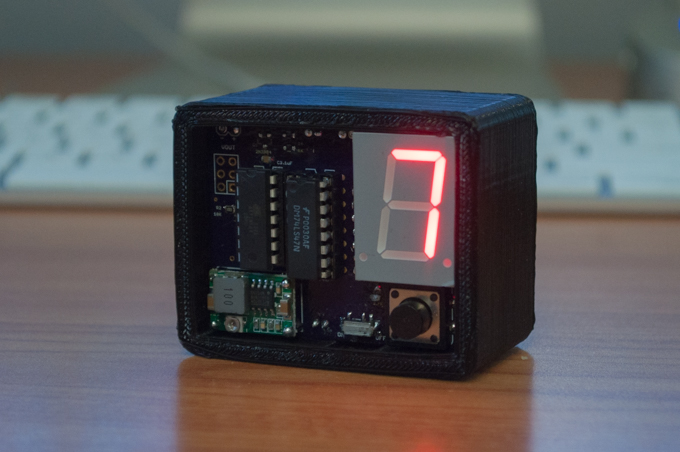
I was bored while I waited for parts for my IN-18 Nixie Clock to arrive from China. So I threw together a silly little ATtiny thing that could use a 7-segment display to display a random number from 0-9. Nothing fancy, just a silly little one-day project. This will come in very handy when the kids argue over who gets the last donut or whatever. Hey kids….pick a number!
Read More... Jan 13, 2018
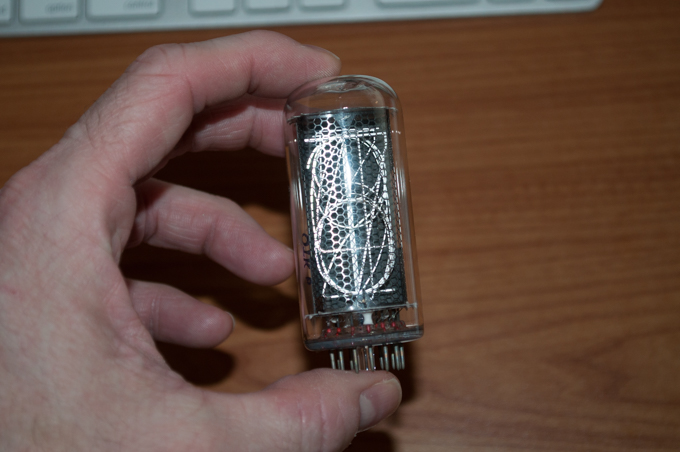
When my wife asked me what I wanted for Christmas, I didn't hesitate: IN-18s. Six of them. After all, it's not everyday someone buys you $300 worth of tubes.
Read More...Oct 10, 2017

I got my PCBs in, assembled everything, and uploaded my code. Everything works as it should. I just need to design a case and it's a wrap!
Read More...Sep 30, 2017

I took a break from the VFD Clock to make a Portal Weighted Storage Cube. That took about a month, and now that it's finished, it's time to revisit the clock.
Read More... Aug 06, 2017

I took a little break from the VFD Clock to work on the Portal Weighted Storage Cube. Paint is drying, and it's supposed to rain tomorrow. So I'll probably have to take a day or two off from painting and sanding. There's no better time than the present to get back to work on the VFD Clock.
Read More...Jun 30, 2017

If you remember my last VFD clock, I attempted to design an AC filament driver for the display. I searched online for a solution and discovered the LM9022 VFD Filament Driver. Like the name suggests, it's specifically design to supply an AC signal to VFD filament from a DC source. It seemed too good to be true.
Read More...Jun 14, 2017

While waiting for the paint to dry on my IN-14 Nixie Clock, I decided to tinker around with a small board idea to do something with this lonely IN-19 that I have. When I bought the IN-14s for my clock, the eBay seller threw one in as a way to make up for a delay in shipping. It's a cool little tube. But what would I ever use it for?
Read More...Jun 04, 2017

In order to start prototyping with my new VFDs, I need to make some breakout boards for them. Experience tells me that there's no easy way to jam them into a breadboard.
Read More...May 20, 2017

This clock is coming along nicely. I know I designed it a few months ago, but I shelved it for a month to wrap other things up. Now that I've decided to go ahead with it, it's been less than a month and it's almost complete!
Read More... Apr 26, 2017

I left off last time with the notion that I'd be able to create a new IN-14-nixie clock based off the design that I used for my IN-12 nixie clock. The plan was to use the main controller board as-is, and combine the driver and display boards. This proved to be more difficult than I had anticipated. The routing of the high voltage traces left much to be desired, simply due to the lack of real estate. I decided to not only use the original controller board, but the driver board too. After all, OSH Park gives you three boards for each order, so I have some left over from the last clock. I might as well use them up.
Read More...Mar 01, 2017

What a long two weeks it's been! I was dying to get my hands on the boards! The assembly was a snap and I think it came out way better than I had imagined.
Read More...Feb 21, 2017
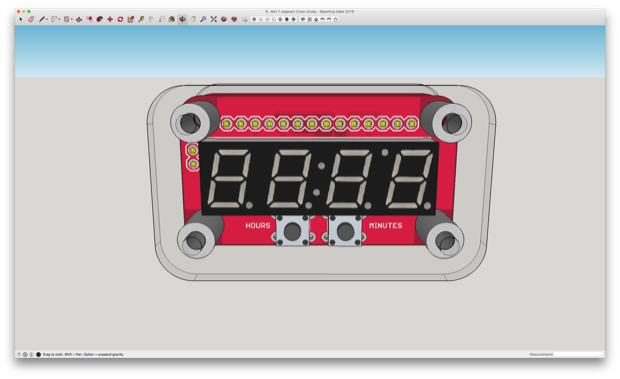
A friend of mine at work cut the cord on his cable TV. Needless to say, the cable box had to be returned. Unfortunately, he relies on that little clock under the TV all the time. He asked if it was possible to basically take my Mini 7-segment Clock V2 and cut it in half. Challenge accepted!
Read More...Jan 28, 2017

All the electronics are complete. I'm so pleased that everything worked on the first go without any tweaks. All that's left to do is design an enclosure for it.
Read More... Jun 13, 2016

After a month and a half of juggling multiple projects, the “Zorg Door Bomb” Clock has finally crossed the finish line. It came out great, and I’m really happy with the results.
Read More... Jun 06, 2016

I was so excited when the board for this clock arrived. This is such a fun project; even if it is just for a laugh.
Read More...May 27, 2016

My PCBs finally arrived! As parts and PCBs become available, I’m bouncing back and forth between this, my 3” LCD Clock and my Zorg Bomb Clock. It seems like all the PCBs showed up within days of each other. So much to do!
Read More...May 27, 2016
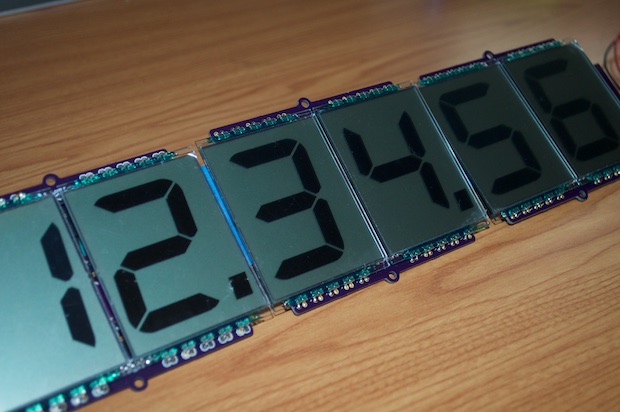
If you've been following along lately, you know I've been juggling multiple projects. It's probably not the best way to do things, but it all just sort of happened. After a few weeks of jumping back and forth between projects, things are really starting to come together. Some of these projects are finally starting to see a finish line.
Read More...May 04, 2016
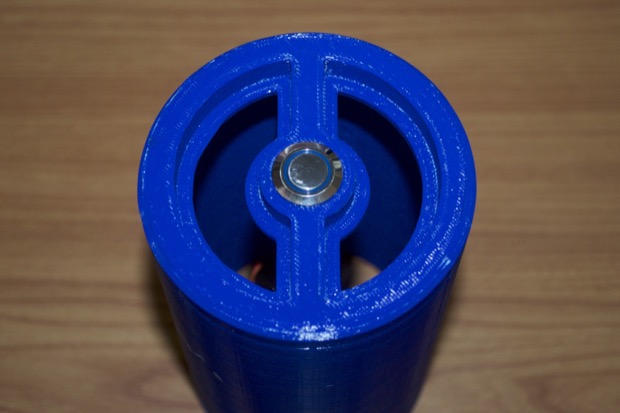
With the prototype working, and the code 99% complete, it was time to put together a PCB and get to work on an enclosure. I really want this clock to look sweet.
Read More...Apr 30, 2016
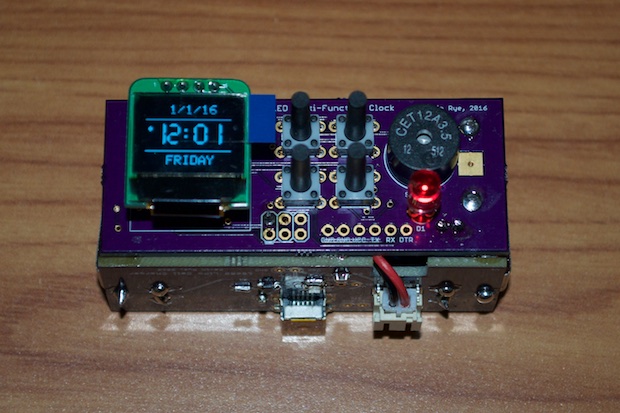
My first attempt at making an 18650 battery charger for my Mini OLED Clock was a disaster. I made some silly mistakes on the board, and needless to say, I let the smoke out. I hope this new board works.
Read More...Apr 23, 2016

It’s the Zorg Door Bomb! The Fifth Element is one of my all-time favorite movies. I watched it again the other day and as soon as I saw Zorg’s Door bomb, I said to myself, “I’m so building that!”
Read More...Apr 23, 2016
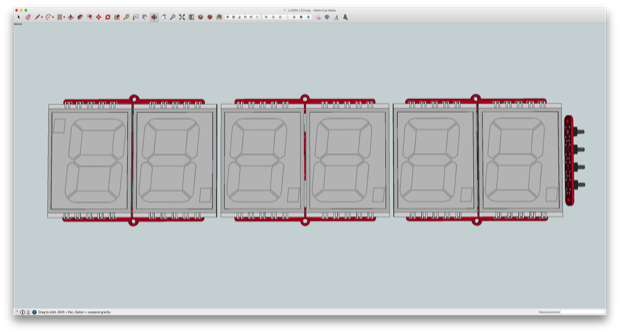
It’s only been 3 weeks since I got my hands on some 3” LUMEX LCDs, but already I have made some fantastic progress with this clock. All the PCBs have been designed and ordered. It’s just a matter of waiting for the PCBs to arrive, designing the enclosure, and putting it together.
Read More...Apr 18, 2016

I’ve had a 74154 4-to-16 Decoder/Demultiplexer sitting in my parts organizer in a drawer marked "Random Chips" for 15 years. So what's it do? Let's find out!
Read More...Apr 14, 2016

In my last post for these awesome 3" LUMEX LCDs, I left off by concluding that I'd need some dedicated LCD driver chips. Well, I have the drivers now, and the displays look sweet!
Read More...Apr 09, 2016

My Multi-Function OLED Clock PCBs arrived. I hit a few snags putting it together, but in the end it came out fantastic. The battery board that was supposed to go with it is a different story.
Read More...Mar 27, 2016

Time for some PCBs! This clock is going to look pretty cool once it’s assembled. With a 3D model, I can get a better idea of what it’ll look like. While the PCBs are being manufactured, I can get to work on coming up with some kind of 3D-printed enclosure.
Read More... Feb 13, 2016
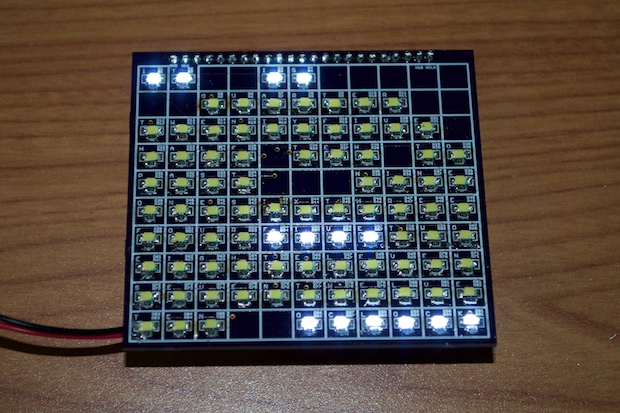
The Word Clock 2 is coming along great. It’s almost complete. This is the most SMD components that I’ve ever soldered onto one board. It was a little challenging, but not impossible. All in all, it took just about 4 hours to assemble and test everything.
Read More...Aug 08, 2015

My new GPS button boards arrived in the mail. I hacked them into my new 3D-printed case. It works perfectly. All that's left is to firm up the code and this one's a wrap.
Read More...Jul 30, 2015

There is still much work to be done. I have to put in a bunch of code for the set buttons, the date, the alarm. Little things. I also still have to design a 3D-printed enclosure for it, as well as order some more nixies for the 2 that arrived DOA. In any case, it's coming along great!
Read More... Jul 22, 2015

I love it when everything just comes together at the end and it just works. No hacks, no head scratching, no second spins. It just works. This project involved some serious engineering, and I'm really happy with the way that it's coming out.
Read More... Jul 21, 2015

Now that I know I can display my own custom time and date on this camcorder CRT, it's time to get serious about a PCB and a 3D-printed case.
Read More...Jul 20, 2015

With the GPS button board designed and ordered, it was time to put together a 3D model and design a new case for the clock.
Read More...Jul 20, 2015

At long last! My nixie main boards arrived. This project has been long in the making, but it's finally starting to come together.
Read More... Jul 06, 2015

The GPS Clock has been fully assembled and sitting on my desk for months. I started this clock two years ago. I just can't seem to get the code to where it needs to be. I just want to put this project to bed already!
Read More...Jun 30, 2015

I've been struggling trying to make the PCBs since EAGLE limits the board size on the free version to 100mm x 80mm. I have to make everything modular. That means one board for the power supply, one for the audio stuff, one for all the logic, and 3 each for the nixies and the drivers. 5 PCB designs, 9 boards in all. They'll all have to be clipped together with wires and headers, etc. The whole thing seems less than ideal. I wanted to be able to just make one big board. I know I can’t make the entire clock one giant PCB. It’ll have to be at least 3 "layers" stacked up, but not made out of 9 separate boards. I bit the bullet and paid the $169 upgrade fee to the EAGLE Hobbyist version. It allows 160mm x 100mm PCBs. What a difference! Now I can make PCBs that are 6.29” long!
Read More... Jun 27, 2015
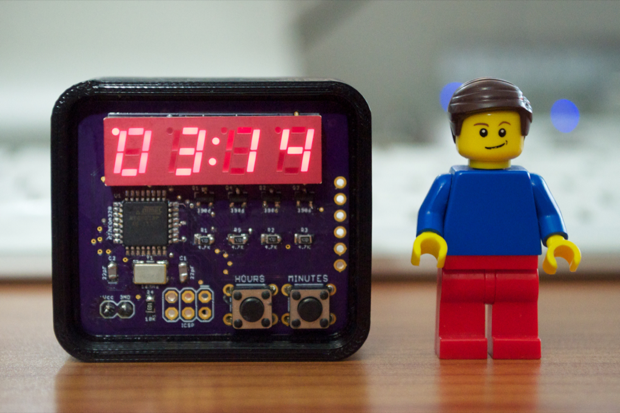
I hope the LEGO minifig gives you a good sense of scale. This clock is pretty small. It's amazing how small the Mini Clock has become after just 3 iterations. I'm really happy with the way that it came out.
Read More... Jun 27, 2015

I just can't sit still. I always have something in the works. I need to always have something in the works. This is especially true when I'm waiting two weeks for a board. I think most of my projects start during the lull of another. I especially like it when a project goes from concept to a PCB order in about an hour! If only every project was like this. I'd have a room full of gizmos!
Read More... May 26, 2015
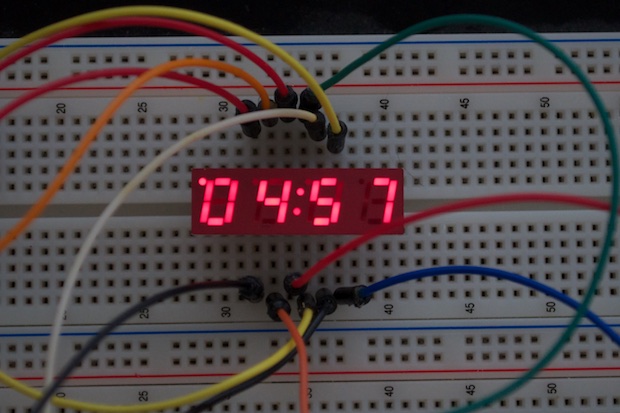
I got my hands on a few really small 7-segment displays around 10 years ago. Back in the day, I didn't have the slightest clue as to how to multiplex them. I just put the wraps on a new 7-segment clock to replace the innards of my old 7490 clock. Seeing how easy it was to multiplex those 7-segment displays, I thought I'd have a go at trying to make another Mini 7-Segment Clock out of one of these teeny-tiny displays.
Read More... May 26, 2015

I'm really happy that it all came together so well. I love when I design a board and it just works. I attacked this project fairly aggressively. It only took me 3 weeks to go from concept to final build. Not to mention, two weeks of that was mostly waiting for PCBs to arrive. I probably saved myself another 2 weeks by already having the enclosure built. The code was relatively straightforward and the PCBs were easy to design since I was able to apply what I've learned from my other clock builds. There wasn't much "R&D" involved at all. I basically just banged this one out.
Read More... May 21, 2015

With the display electronics complete, it was time to move beyond the concept phase and begin the actual prototyping of the 3D-printed frame. It came out better than I could have anticipated. I totally nailed it!
Read More... May 18, 2015
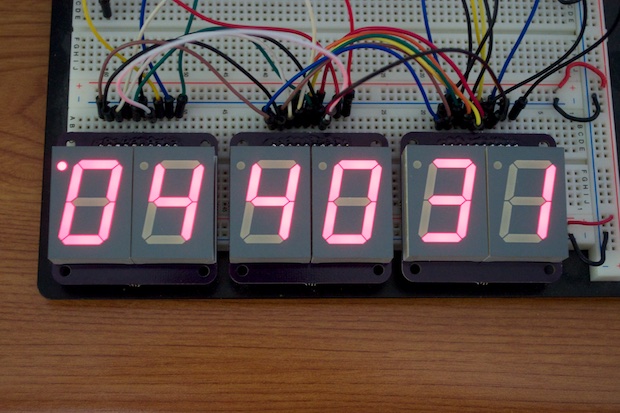
After a 13-day wait, I had my 7-segment LED breakout boards in-hand. It only took a few minutes to solder the boards together. I just have to wait a few more days for the colon boards and I can finalize the 3D-printed frame.
Read More... May 11, 2015

I was extremely satisfied (and proud) of the way that the enclosure turned out for the rework of my 7490 Clock. The electronics on the other hand, is another story. The innards of that clock were from a prototype I built in 2001. It was a proof of concept. It led to the design of what would become an extremely well-polished and accurate clock. It's just a shame to throw it in a closet and forget about it. The case came out so nice and it looks great in the living room. I'm going to gut it, and replace my old 7490 prototype board with something brand new.
Read More... Nov 08, 2014

If you’re following along, you know that version 1.0 of my GPS clock was a total bust. I somehow managed to screw up the PCB. I had the FTDI RX and TX lines tied to the wrong port on the ATmega2560. There was just no way to rework the board. Besides, I like to keep my final projects looking neat and clean. Rework wires are just a big no-no in my book. That meant that I had to fix the error on the PCB and place another order. I got my boards and most of my parts. I soldered together what I could. So far, it looks like it’s going to work!
Read More... Oct 18, 2014

Many a time have I had to set up my Arduino UNO as an ISP in order to burn the bootloader to either another Arduino or an SMD project. It’s a pain every time having to look up the pinouts and construct a cable each time. Having a shield is so much easier than messing around with jumper wires and DIY homebrew cables.
Read More... Oct 06, 2014

In order to drive a nixie, you can use a 74141 BCD decoder. Sure, you can use transistors, but you’ll need a bunch of them. You can drive all 10 nixie segments off one 74141 chip. All you have to do is feed it a number in binary and the chip lights up the corresponding cathode on the nixie; the same way you’d drive a 7-segment display with a 74247.
Read More... Oct 02, 2014

Rev 1 of my IN-12 Nixie Breakout Board was an abomination. Upon realizing that the nixie footprint that I used for the PCB was completely wrong, I immediately re-spun the board. I got it right this time. All ten digits light up when the corresponding pin is grounded on the 10-pin header.
Read More... Sep 25, 2014

I was amazed at how fast my GPS PCBs arrived in the mail. Usually OSH Park takes a good 2 weeks to turn around a board. However, this time they arrived in 5 days. The boards look great...and they arrived just in time for the weekend!
Read More... Sep 20, 2014

After a long month of waiting for PCBs, nixie pins, nixie sockets, and resistors....I was finally able to assemble my IN-12 Nixie Breakout Boards. Too bad the pinouts are backwards and half the digits don’t work. See, this is why we prototype!
Read More... Aug 03, 2014

I’ve been wanting to build a nixie clock for over 15 years, ever since I saw the TTL nixie clock my Dad build in the 70s. Being a young lad, I was very apprehensive in dealing with the high voltages required to fire nixies. I just never had the guts. Back in 2001, I figured I’d start out small and design a TTL clock using 7490s and 7-segment LEDs. The whole clock runs off 5V and there’s zero chance of being electrocuted. It’s been a long time coming, but I think it’s finally time to bite the bullet and make a nixie clock. I’ve learned so much over the past few years working with the Arduino platform, that I’ll be able to apply what I’ve learned from all my other clock projects.
Read More... Jul 23, 2014

I did it! I finally finished upgrading the clock internals and the enclosure. I think it came out amazing. I just can’t believe after all these years that this clock finally looks like something I can be proud to display. I’m really happy with the results.
Read More... Jul 09, 2014

The last prototype Arduino board I made for the 7490 clock rework didn’t turn out as well as I had hoped. The board did what it was supposed to do, but the implementation wasn’t that great. The more I thought about it, the more it became clear that the Bare Bones Arduino boards I designed months ago were the perfect solution. After all, it’s projects like these that inspired me to create the Barebones Arduino in the first place.
Read More... Jun 15, 2014

Since I wasn’t happy with the engraving on the first spin, as well as totally forgetting to make a cut out for the display, I revised my SVG file and resubmitted it to Ponoko. As far as the color, I think it’s going to look pretty good. I might lower the value of the resistors in order to brighten up the digits. I’ll have to see what it looks like when it’s all put together.
Read More... Apr 22, 2014

My Mini 7-Segment Clock kit is a go! All my parts have come in and it’s all ready for sale! It's a neat little kit, and a neat little clock. I warn you though, it's not for the faint-of-heart! This is no beginner-kit. It's 80% SMD, so ninja skills with a soldering iron are required. Not to mention you’ll need to burn the bootloader on the Atmega.
Read More...Feb 08, 2014

I love that feeling you get when you spend weeks working on a project, it all comes together in the end and it just works. I’m really happy with the way that version 2 came out.
Read More... Feb 06, 2014

I received the PCBs for the Temperature Shield a week or two ago, but I had to hold off on putting them together. I had a few other things to wrap up first. I also needed to order some more DS18B20 temperature sensors. I finally have all my parts now as well as a little free time, so it’s time to put this one together.
Read More... Jan 25, 2014

I left off with my MEGA MINI boards not working. I was banging my head against the wall trying to figure out what went wrong. I figured I’d shelf it for a week and look at it again another day with a clear head. I posted my schematic on the Arduino forums and asked if someone could lend a second set of eyes and let me know if it made a stupid design error. It turned out I had .1uF caps on the crystal! Can you believe it?
Read More... Jan 23, 2014

My Mini 7-Segment Clock has to be one of my favorite projects to-date. I really like the way that it came out. It's so tiny!
I’ve had a lot of people ask me if I plan on selling a kit for it. I even received an email from a reader who sent off to have some boards fabbed. He put one together himself and reported that it worked out great. When someone else builds one of your designs, it's a nice little pat on the back.
Read More... Jan 22, 2014

I was pretty chuffed with myself for coming up with the idea for my mini Button Breakout Board. I was pretty happy with how it came out. It’s only been a few months and already it has come in handy a few times. It’s just that it could be a little better. Everything can always be better!
Read More... Jan 14, 2014

It’s only been 12 days and already I have my PCBs in-hand. This was such an easy build, and they work great. Now I just have to wait for my Temperature Shield to come in and I can complete my first project with one of these.
Read More... Jan 11, 2014

After a 2-week wait, my MEGA MINI PCBs arrived in the mail. They turned out pretty cool. I assembled two of them and installed Atmega Studio on my PC. Unfortunately, I can’t seem to write the bootloader to them. I was able to read one of the chips, but after a quick lunch break, it stopped working. I hope I didn’t kill $36 bucks worth of Atmega2560s!
Read More... Jan 02, 2014

With version 3 of my Bare Bones Arduino board off being fabbed, as well as the laser-cut acrylic, it was time to go ahead a design my first shield.
Read More... Jan 02, 2014
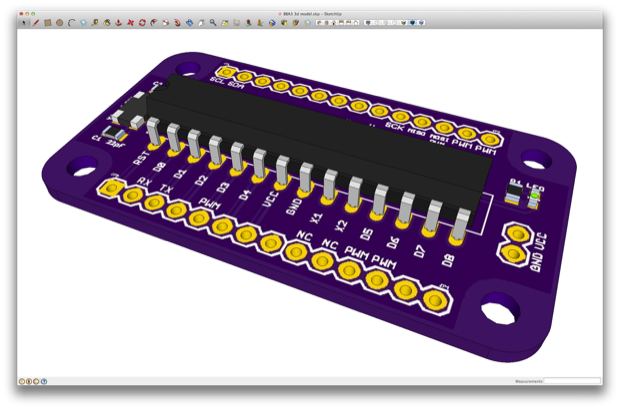
I really liked the way that my Bare Bones Arduino boards came out. Both versions. They’ve really come in handy. They’re great for throwing quick projects together. However, I’d like to make a new version with holes so that they can be mounted between some sheets of acrylic. I’d also like to swap out all the through-hole components for SMD versions.
Read More... Dec 16, 2013
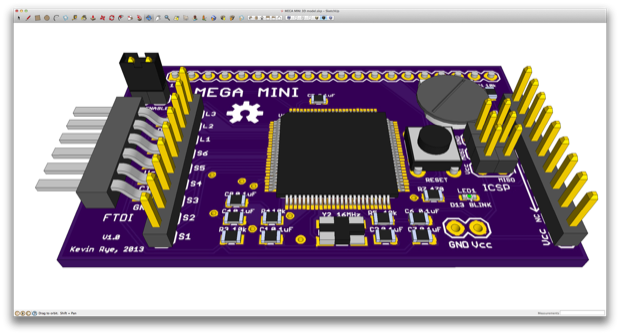
I’d hate to spend a good $40 bucks on the PCB for my GPS clock and find out that I screwed something up, or that I can’t solder an Atmega2560. I figured that I’d spare myself the possibility of wasting $100 bucks worth of hardware and chalk up a mini-board for the Atmega2560. Sort of a “bare bones” MEGA as a test-run.
Read More... Dec 06, 2013

I’ve made a few devices already that have used 0603 SMD LEDs. 0603 LEDs are beyond tiny and they’re a little trickier to work with when orientation matters. It would be so much easier if I had a quick and dirty means of testing the orientation before soldering one.
Read More... Dec 05, 2013

I’d like to try my hand and making a Tesseract. I love all the Marvel movies, as well as my kids. So I think they’ll get a kick out of seeing one on my desk.
Read More... Nov 18, 2013

I came up with the idea that it would be cool to have a little button breakout board that I could quickly pop on to my breadboard when I suddenly found myself in need of some buttons. Instead of scrounging for buttons and resistors and taking up a whole ton of space, I could just simply connect a "mini keyboard" to the breadboard and be up and running in seconds.
Read More... Jul 30, 2013

It’s been a good month since I submitted my PCBs for version 1.1. It seemed to take forever for the PCBs and acrylic to come in this time. I was so happy to finally put this guy together and complete the project.
Read More... Jul 16, 2013
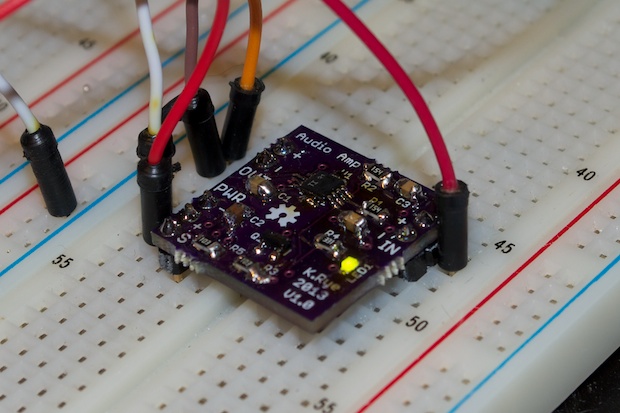
I last left off with my Audio Amplifier PCB being a total bust. Well, not a total bust. It probably works, but I’ll never know. I’ll never be able to solder the super-tiny 8SON package that I put in version 1. Once I received the larger 8MSOP version from DigiKey, it was obvious that it was the size to use. It definitely looks like I’ll have less difficulty soldering it by hand.
Read More... Jul 01, 2013

My mini audio amp practice boards came in. I wasn’t too sure if I’d be able to solder the TPA2005D1 chip or not. Rather than waste $45 on the LCD Clock V2 PCB and make a mess of it, I figured it would be a good idea to make a practice board based off SparkFun’s breakout board. If I can’t solder the part by hand, then I’ll just incorporate SparkFun’s audio amp breakout into my clock PCB as a daughterboard.
Read More... Jun 23, 2013

I received my Mini 7-Segment Clock PCBs. I’m pretty excited to put one together. I think it’s going to look pretty cool, as tiny as it is.
Read More... Jun 12, 2013

My E-Paper boards finally arrived. I wasted no time in putting one together. I was really excited to see if I got everything right. Needless to say, I totally nailed it! It's so awesome putting in that last piece, powering it on and seeing all your hard work pay off!
Read More... Apr 20, 2013

I finally received the 30 RGB LED breakout boards that I designed for my RGB Night Light. Time to get my build on!
Read More... Apr 08, 2013

After a few failed attempts at making a home made PCB for my ATtiny Programming shield, I decided to go ahead and upload my Eagle file to OSH Park.
Read More... Apr 05, 2013

Although I’m pretty happy with the way my Bare Bones Arduino boards came out, they could be smaller. I give you…version 2!
Read More... Apr 01, 2013

The Bare Bones Arduino PCBs that I ordered from OSH Park came back. It took 13 days to turn them around. It always seems like such an eternity!
Read More... Mar 23, 2013

Board etch FAIL. The toner transfer method is a no go, at least not with my laser printer anyway.
Read More... Mar 21, 2013

It’s been a good 12 years since I’ve etched my own board. I’ve been meaning to give it another go for some time, but it can be rather time consuming and the end results just don’t hold a candle to professionally made boards. I needed some parts from Jameco, so I tossed some Etchant powder into my order while I was at it. I’ve used the liquid in the past, but the powder was cheaper. I figured I’d give it a try.
Read More... Mar 19, 2013

Back in January when I discovered the SoundBox PCBs were junk, I kicked around the idea of making a bare bones Arduino board in favor of dedicated PCBs for simple spur-of-the-moment projects. Firing off a quick project would then just be a matter of code.
Read More... Mar 18, 2013

Since I finished the Word Clock, and I'm waiting for SparkFun to send me a new e-paper display, I figured it was a good time to start playing around with the ATtiny85s that I picked up a few months ago.
Read More... Jan 29, 2013

After 18 days, my Word Clock PCBs finally arrived. Man, does it take forever for them to turn around a board!
Read More... Jan 27, 2013

It happens to the best of us. You design a board. Wait for the board. Get the board. Assemble the board. Board doesn’t work.
Read More... Jan 06, 2013

I completed the PCB for the Word Clock last night, but I slept on it for the night before submitting it. It’s a good thing too, because I thought of something else.
Read More... Jan 02, 2013

I completed the circuit for the
FartBox. It’s time to put the wraps on a PCB and send it out to be fabbed.
Read More... Dec 07, 2012

Woo hoo! The boards I designed for my Arduino LCD Clock have finally arrived! They look awesome!
Read More... Nov 20, 2012

My Arduino LCD Clock PCB is complete and ready to be fabbed.
Read More... Nov 08, 2012

With the clock code complete, it was time to hop online and order my parts. With the parts in hand, I’ll have an easier time laying them out on the PCB and getting the spacing right.
Read More... 
























































































